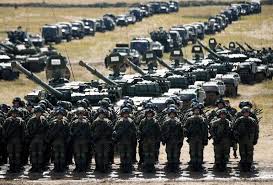The presence of Russian forces near Ukraine has baffled American officials, clouding the Biden administration’s response.
Some Republican congressmen have urged the US to increase military aid to Ukraine. However, these risks turn what could be merely Russian President Vladimir Putin flexing his muscles into a full-fledged showdown, putting Ukraine in even more danger and potentially triggering an energy crisis in Europe.
However, a sluggish American response brings its own set of dangers. It may empower Putin to take more severe measures against Ukraine, as fears rise that he may try to annex more of its territory. And it might further undermine President Joe Biden’s political standing at a time when his support is dwindling.
If the US had a clearer grasp of what Putin was trying to achieve, it would be easier to strike the correct balance. Top officials, on the other hand, confess they have no idea.
Defense Secretary Lloyd Austin said Wednesday, “We don’t know exactly what Mr. Putin is up to.” “We don’t have clarity into Moscow’s goals, but we do know its playbook,” Secretary of State Antony Blinken stated a week ago.
Rep. Mike Quigley, a Democrat from Illinois who serves on the House Intelligence Committee, said that better understanding Putin’s intentions are vital “to prevent the blunders that have started catastrophic wars.”
Any response by the United States must be managed to avoid being “appeaser or provocateur,” he added.
“Trying to get information in this area is quite difficult,” he stated. “It’s a struggle that’s as tough as it’s ever been, if not tougher.” It has a significant impact on our ability to make sound decisions.”
In 2014, Russia annexed Ukraine’s the Crimean Peninsula, and a battle in eastern Ukraine between Kyiv and Russian-backed separatists in the Donbas region has claimed the lives of an estimated 14,000 people. According to Ukraine, 90,000 Russian troops have gathered along the border.
It’s possible that the buildup is a precursor to another Russian invasion. Blinken told Ukraine’s foreign minister earlier this month that Putin’s “playbook” was for Russia to build up forces near the border before invading; claiming “falsely” that it had been provoked.
NATO Secretary-General Jens Stoltenberg said on Friday that the alliance is seeing an “extraordinary concentration” of Russian military along Ukraine’s border, warning that Moscow has used similar forces to intervene in neighboring countries in the past.
Despite the fact that US officials do not believe an invasion is imminent, Putin has increased his dismissive attitude toward an independent Ukraine. Ukrainians and Russians are “one people,” according to a lengthy essay issued by the Kremlin in July, and “real sovereignty of Ukraine is conceivable only in collaboration with Russia.”
However, the steps could be saber-rattling in order to prevent Ukraine from moving closer to the West or joining the North Atlantic Treaty Organization, both of which Putin opposes. It’s unclear if Russia would risk invading Ukraine and igniting a far more difficult conflict, or if it would prefer to occupy unfriendly territory.
Despite the fact that a similar Russian military buildup in the spring did not result in an invasion, lawmakers and officials say they are more anxious now, citing unreleased US intelligence.
Russia denies having hostile motivations, claiming it is reacting to increased NATO action near its borders and Ukraine’s military strengthening.
“It should be taken into account that Western partners are escalating the situation by sending lethal contemporary armaments to Kyiv and conducting provocative military maneuvers in the Black Sea — and not only in the Black Sea but also in other places close to our borders,” Putin said on Thursday.
As part of NATO’s activity alongside Ukraine, the US has moved ships into the Black Sea, and in recent weeks has delivered military supplies as part of a $60 million package announced in September. Since 2014, the United States has pledged to invest more than $2.5 billion in Ukraine’s defense.
The White House expressed optimism for a de-escalation of tensions. “As we have stated previously, escalatory or confrontational measures by Russia would be of considerable concern to the US,” a National Security Council spokesperson said in a statement.
In recent weeks, there has been a frenzy of diplomacy. U.S. authorities have visited both Russian and Ukrainian colleagues, including CIA Director William Burns’ visit to Moscow, during which he spoke by phone with Putin. A joint statement from Germany and France reaffirms their support for Ukraine.
In the end, the United States appears to have few viable choices for stopping Putin if he continues on his current path.
In April, the Biden administration placed further sanctions on Russia for its alleged role in the Ukraine crisis, as well as charges that it aided cyberattacks on US infrastructure and electoral meddling in the United States.
More penalties are unlikely to impact Putin’s behavior, according to politicians and analysts. In May, the Biden administration lifted sanctions on the Nord Stream 2 pipeline, which will transport Russian natural gas directly to Germany without traveling through Ukraine.
This month, a group of Republican congressmen demanded that the US send more lethal aid to Ukraine’s military, increase intelligence cooperation, or establish a stronger military presence in the Black Sea. Russia, on the other hand, might immediately respond with more forces.
Putin may also retaliate against any Western action by restricting Russian energy shipments to Europe, which is highly reliant on Russian natural gas.
“The usual tools that nation-states employ to manage the behavior of other nation-states are no longer available,” Douglas Wise, a former deputy director of the Defense Intelligence Agency, stated. “There isn’t much at stake for the Russians.”
Two analysts wrote for the Carnegie Endowment for International Peace that Putin may seek to convey a message to the US that Russia must be treated “as a key force that cannot be sidelined on the US agenda.” But, according to the analysts, Ukraine is Putin’s “unfinished business.”
“That unfinished business,” Eugene Rumer and Andrew Weiss said, “is the restoration of Russia’s sovereignty over major areas of her historic empire.” “There is no item on that agenda that is more crucial — or pivotal — than Ukraine’s return to the fold.”
Taking more of Ukraine — or perhaps pushing all the way to Kyiv — would be far more difficult than capturing Crimea or areas of eastern Ukraine, according to Paul Kolbe, a former CIA officer who heads the Belfer Center’s Intelligence Project.
Many of Putin’s goals may be achieved without an invasion, according to Kolbe, by applying pressure on Ukraine and NATO and developing a rift between allies on how to respond.
“It fits into a larger pattern of ensuring that they do not perceive threats on their close borders,” he explained.

















